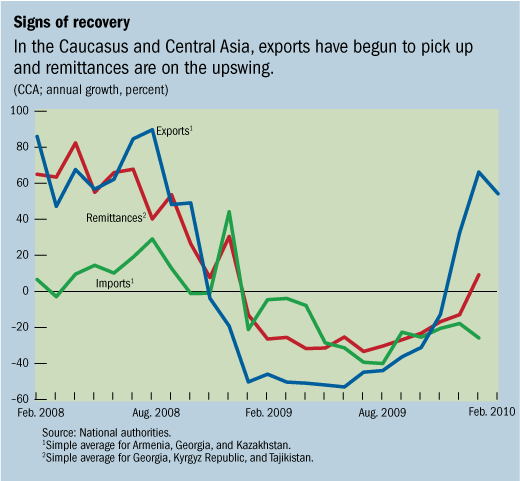
Typical street scene in Santa Ana, El Salvador. (Photo: iStock)
IMF Survey: IMF Sees Early Signs of Rebound in Central Asia, Caucasus
May 25, 2010
- Recovery seen across region, but at variable rates
- Reviving private sector credit growth is key concern
- Additional donor support needed in some low-income countries
The Caucasus and Central Asia (CCA) is showing signs of a nascent rebound, but financial sector stress poses a risk to the region’s recovery, says the IMF’s latest forecast.

Cotton mill worker in Turkmenistan: Growth will be strongest in the CCA’s energy-exporting countries, led by Turkmenistan (photo: Tim Brakemeier)
REGIONAL ECONOMIC OUTLOOK
According to the recently released Middle East and Central Asia Regional Economic Outlook, the CCA region’s output is projected to expand to 4.3 percent in 2010, up from 3.5 percent in 2009.
“Exports have begun to pick up, the decline in remittances appears to be slowing or reversing, and capital inflows have turned positive,” the IMF’s Middle East and Central Asia Department Director Masood Ahmed told a press conference. “However, these trends are far from uniform and, in a number of countries, stress in the banking sector is holding back credit growth and weighing on economic activity.”
Sizable shocks
The CCA region was hit hard by external shocks in 2009. Exports of goods and services fell across the region, and several countries saw remittance inflows, mainly from Russia, drop by up to a third. International financial market turmoil had the greatest impact on Kazakhstan, which is more integrated with global financial markets than other countries in the region, and, to a lesser degree, Armenia and Georgia.

The impact on growth of these sizable external shocks—which were felt most acutely by the oil importers—was cushioned by government’s policy response and, in some cases, donor support. Some countries put in place countercyclical fiscal and monetary policy, which helped moderate the impact of the shocks. For CCA energy importers, donor support helped finance the fiscal stimulus, while the energy-exporting countries relied on savings.
Uneven recovery across region
The IMF projects recovery across the region as the revival of the global economy—in particular, Russia, which has close ties with CCA countries—picks up speed. Exports started to increase in most of the region’s countries during the second half of 2009. There is evidence that the decline in remittances is slowing in some countries, the report notes, while in others, they are on the increase. And capital inflows have also turned positive, although they remain lower than before the crisis.

In 2010, growth will be strongest in the CCA’s energy-exporting countries, led by Turkmenistan and Uzbekistan, which are projected to expand by 12 and 8 percent, respectively. Energy-importing Armenia, hit hard by the bursting of a construction boom, is forecast to grow just 1.8 percent, up from -14 percent in 2009. Other energy importers are slated to grow at between 2 and 4 percent in 2010.
Policy response
The report notes that a key concern for policymakers is stress in CCA banking systems, which has caused a sharp slowdown in private-sector credit and is hampering growth. Policymakers should help banks repair their balance sheets by recognizing losses and dealing with nonperforming loans, the report stressed, noting that in some cases, temporary government liquidity injections to overcome funding problems may be needed to restore credit growth.
With regard to fiscal policy, the IMF report recommends that, as growth gains traction, energy exporters should wind down expansionary fiscal policy to prevent a buildup of inflationary pressures. CCA energy importers, on the other hand, have limited fiscal space and should mostly aim for a neutral fiscal stance or modest fiscal adjustment in 2010. In some, public debt has increased sharply. For these countries, some of which also have a large number of poor citizens, it is important for continued donor support to cushion the blow until private sector activity picks up to sustain growth and improve living standards.
The report also addresses the issue of dollarization, which has historically been high in many CCA countries and was a key channel through which the global crisis was transmitted to the region. Dedollarization would help reduce vulnerabilities arising from currency mismatches, the report says, and CCA countries should seek to return to their pre-crisis paths of dedollarization by maintaining macroeconomic stability and enacting supportive regulatory measures.







